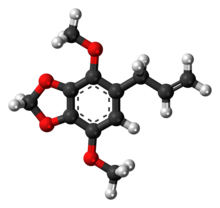Apiole

| |

| |
| Names | |
|---|---|
| Preferred IUPAC name
4,7-Dimethoxy-5-(prop-2-en-1-yl)-2H-1,3-benzodioxole | |
| Other names
5-Allyl-4,7-dimethoxybenzo[d][1,3]dioxole
1-Allyl-2,5-dimethoxy-3,4-methylenedioxybenzene | |
| Identifiers | |
3D model (
JSmol ) |
|
| ChEBI | |
| ChEMBL | |
| ChemSpider | |
ECHA InfoCard
|
100.007.592 |
| EC Number |
|
| KEGG | |
PubChem CID
|
|
| UNII | |
CompTox Dashboard (EPA)
|
|
| |
| |
| Properties | |
| C12H14O4 | |
| Molar mass | 222.23 g/mol |
| Density | 1.151 g/mL |
| Melting point | 30 °C (86 °F; 303 K) |
| Boiling point | 294 °C (561 °F; 567 K) |
Except where otherwise noted, data are given for materials in their standard state (at 25 °C [77 °F], 100 kPa).
| |
Apiole is a
In medicine it has been used, as essential oil or in purified form, for the treatment of menstrual disorders and as an abortifacient. It is an irritant and, in high doses, it can cause liver and kidney damage.[3] Cases of death due to attempted abortion using apiole have been reported.[4][5]
Hippocrates wrote about parsley as an herb to cause an abortion.[6] Plants containing apiole were used by women in the Middle Ages to terminate pregnancies. Now that safer methods of abortion are available, apiol is almost forgotten.
Orthography
Apiole (always with the final 'e') is the correct spelling[
Other similarly named compounds
The name apiole is also used for a closely related compound found in dill and in fennel roots, the positional isomer (dillapiole, 1-allyl-2,3-dimethoxy-4,5-methylenedioxybenzene. Exalatacin (1-allyl-2,6-dimethoxy-3,4-methylenedioxybenzene) is another positional isomer of apiole, found in the Australian plants Crowea exalata and Crowea angustifolia var. angustifolia.[citation needed]
See also
References
- ISBN 9781845934057.
- ^ Shorter, Edward (1991). Women's Bodies: A Social History of Women's Encounter With Health, Ill-Health, and Medicine. New Brunswick, NJ: Transaction Publishers.[page needed]
- PMID 5736450.
- PMID 20325694.
- PMID 13320936.
- ISBN 978-0-9645920-0-1.[page needed]
- S2CID 4189608.[failed verification]
- PMID 26826679.
- PMID 6499112.
